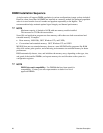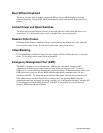SRPL8 Server System Product Guide 27
Peripherals
Super I/O Chip
The 37C937 Super I/O device supports two serial ports, one parallel port, diskette drive, and
PS/2-compatible keyboard and mouse. The system provides the connector interface for each port.
Serial Ports
Both serial ports are relocatable. By default, port A is physically the left connector (as you look at
the back of the system — see Figure 3 on page 17), port B the right connector. Each serial port
can be set to one of four different COMx ports, and each can be enabled separately. When
enabled, each port can be programmed to generate edge- or level-sensitive interrupts. When
disabled, serial port interrupts are available to add-in boards.
Parallel Port
The 25/15-pin connector stacks the parallel port over the VGA. The 37C937 provides one
IEEE 1284-compatible 25-pin bidirectional EPP (supporting levels 1.7 and 1.9). BIOS
programming of the Super I/O registers enables the parallel port and determines the port address
and interrupt. When disabled, the interrupt is available to add-in boards.
Add-In Board Slots
The I/O carrier has ten 64-bit PCI buses contained in four PCI segments:
• PCI-A provides for PCI slots 1 and 2 (33 MHz), dual-channel LVDS SCSI controller, video,
and PIIX4E.
The PIIX4E controls communications to IDE, onboard ISA, USB, and Super I/O for
handling the keyboard, mouse, diskette drive, parallel port, and serial ports.
• PCI-B provides for PCI slots 3 through 6 (33 MHz).
• PCI-C provides for slots 7 and 8 (two of the 100 MHz PCI-X, 3.3 V slots).
• PCI-D provides for slots 9 and 10 (the two other 100 MHz PCI-X, 3.3 V slots).
Video
The onboard, integrated ATI Rage XL 64-bit VGA chip contains an SVGA controller that is fully
compatible with legacy video standards. The standard system configuration comes with 8 MB of
onboard SDRAM memory. The video controller supports pixel resolutions of up to 1600 x 1200 at
85 Hz and up to 16.7 M colors.
The SVGA controller supports analog VGA monitors (single and multiple frequency, interlaced
and noninterlaced) with a maximum vertical retrace noninterlaced frequency of up to 100 Hz.
You cannot add video memory to this system. Depending on the environment, the controller
displays up to 16.7 M colors in some video resolutions. It also provides hardware-accelerated bit
block transfers (BITBLT) of data.


















